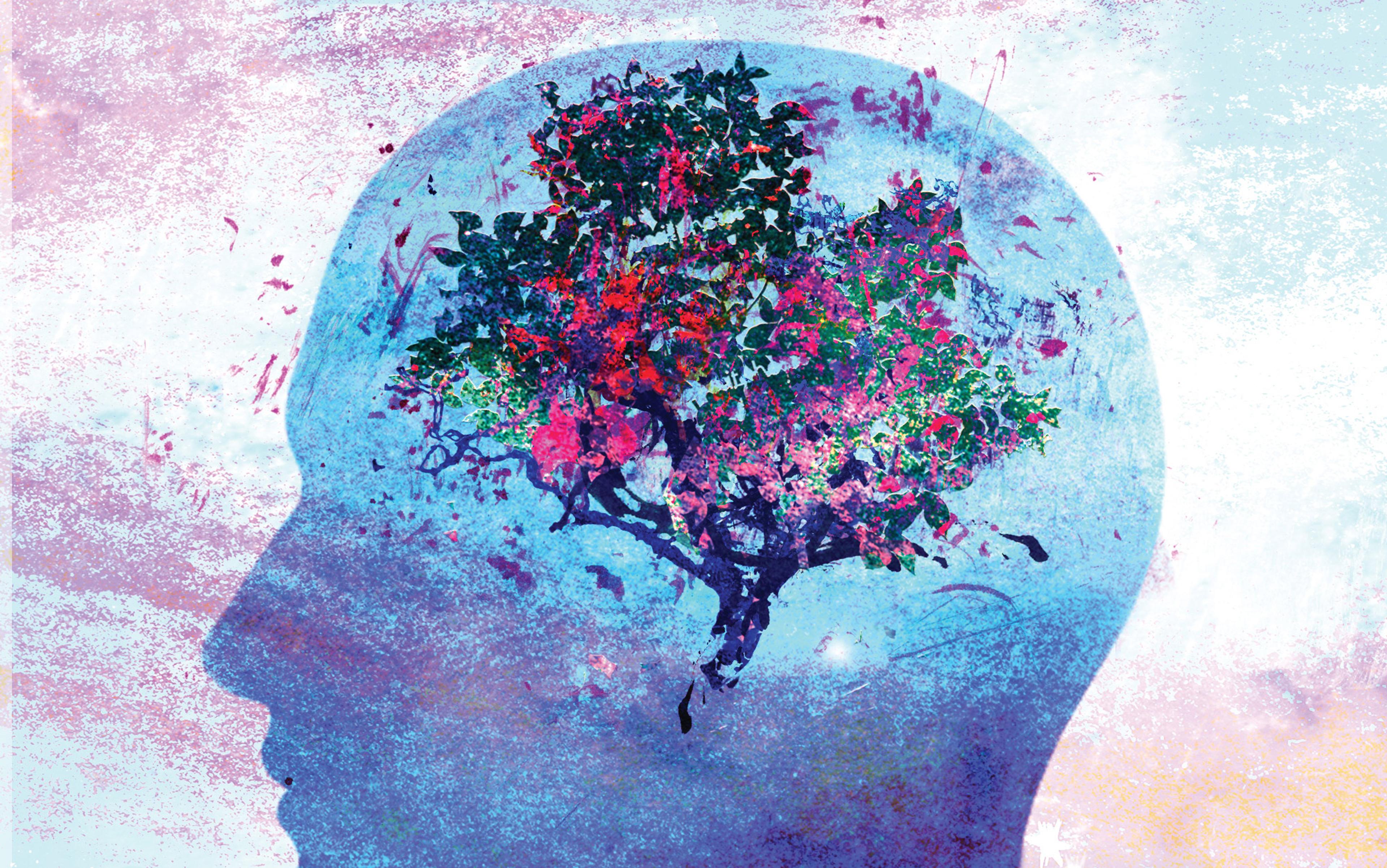When I got depressed for the first time, at age 27, what surprised me most was the sheer physicality of it. My arms and legs, numb and pendulous as dumbbells, resisted my half-hearted attempts to animate them, and my perception was equally leaden. Taking in the world felt like gazing through a stained-glass pane, trying to make out the wavy shapes on the other side.
After a few rounds of cognitive-behavioural therapy (CBT) – which helped, but not quite enough – I gave in and tried fluoxetine (Prozac), which resolved the depression so completely that I felt baptised, reborn. I ran around the mall trying on clothes as if I were outfitting myself for a new life. I assumed, or willed myself to, that the profound physical and mental torpor that had overtaken me was a one-off, a fluke. (And in fact, millions of people experience only a single depressive episode in their lifetimes.)
But for me, what the clinical psychologist and author Andrew Solomon has called the noonday demon did strike again. It arrived most dramatically after the birth of my second son – the leaden limbs and outlook, the gagging when I forced down a bite of food, the glug-glug rush of blood through my ears when anxious thoughts crept in. Because this was a dark wolf I now knew, I acted more quickly this time, resuming talk therapy and seeking a new fluoxetine prescription.
With the new prescription came a recommendation from my psychiatrist: that I stay on fluoxetine indefinitely. It would stave off future episodes of depressive illness, he explained, which was critical to my long-term wellbeing. His advice seemed in line with an evolving medical understanding of depression I’d heard about – the kindling hypothesis. Like a vessel that develops more cracks each time it’s dropped, the theory goes, sufferers of disorders such as depression, bipolar disorder and post-traumatic stress disorder (PTSD) become more neurologically brittle with each active bout of mental illness. As a result, future episodes occur closer and closer together, with less and less provocation. The key to disrupting this sequence is to prevent episodes before they have a chance to occur.
When I’d first caught wind of kindling theory years before, I’d thought: Well, that’s the most depressing thing I’ve heard in a while. I had banished antidepressants from my life – for good, I thought at the time – and I was loath to consider that I might need to take them indefinitely, like a diabetic on insulin maintenance.
But now, despite my misgivings, I felt driven to ask my doctor about kindling. Was it true that with every bout of depression, my brain might be changing in ways that made me more susceptible to future illness? He indicated that I should take the prospect seriously – and that prevention was paramount. My choices suddenly seemed stark: stay on antidepressants long term, with all the side effects and stigma that entailed, or risk a default course that could be my mental undoing.
Kindling is among the most arresting and intuitive metaphors in neuroscience. As bonfire-builders know, a log from a tree’s heart seldom burns on its own. But pile more twigs and detritus on top – the kindling – and the log bursts into flame. Mental-health specialists, especially psychiatrists, speak of certain clients as being ‘kindled’ by traumatic experiences or previous bouts of illness. True to their chosen metaphor, they watch these clients as they might a smouldering fire ring, alert to even subtle signs of flare-up.
The rough contours of kindling theory first coalesced not around a psychiatric disorder, but a neurological one – epilepsy. In the early 1960s, the physiologists José Delgado and Manuel Sevillano at Yale University electrically induced mild seizures in a group of cats. They noticed that the more they stimulated seizures, the more severe the cats’ seizures became.
Later in the decade, the psychologist Graham Goddard at Waterloo University in Canada expanded on the Yale findings in his studies of rats. With each seizure that Goddard’s team induced, the intensity of the animals’ seizures ratcheted up. And after one series of seizures, new seizures came on more easily: a shock that would hardly have made the animals flinch at the beginning later brought on a major convulsion. The persistent activation of the brain pathways responsible for seizure activity seemed to be priming these pathways to respond more and more readily. Goddard applied the term ‘kindling’ to this distinctive progression, which naturally occurring seizures can also set in motion. Since then, clinical evidence has accumulated to such a degree – in humans as well as animals – that kindling is widely accepted among neurologists as an apt depiction of epilepsy’s course.
The pronounced hormonal response might help someone outrun a lion on the savannah, but when the stress response is sustained, it turns pathological.
It was the psychiatrist Robert Post at George Washington University who floated a retooled version of kindling theory in the psychiatric realm. In the late 1980s and early ’90s, Post and some of his colleagues noted that mood disorders tended to follow a predictable progressive sequence. When people had their first episode of illness, they could typically point to an adverse life event that brought on the episode: a divorce, perhaps, or a job loss or cancer diagnosis. But successive episodes were less likely to be preceded by adverse events, and there were often shorter and shorter intervals between them. Stretches of active illness, Post proposed, might spur changes in the brain that made future depressive episodes more likely.
Post had cut his teeth by studying kindling’s influence on seizure activity. It was only natural for him to borrow the metaphor to describe a variety of mental disorders involving depressed mood, including bipolar disorder and PTSD as well as unipolar depression. ‘The kindling model helps us think about the progression, the unfolding and evolution of the illness,’ he told The New York Times in 1988. Since then, Post has published a raft of papers arguing in favour of kindling theory, which he says helps to illuminate predictable neural processes that can – thankfully – be halted. ‘With appropriate psychotherapeutic and pharmacotherapeutic intervention,’ Post has written, ‘episodes and episode progression can be prevented.’
Though Post’s proclamations about kindling have an assured tone, researchers still don’t completely understand the biological mechanisms that might drive the kindling process. But there is enough evidence to assemble a plausible picture. One pertinent observation is that mood disorders seem to inflict gradual brain damage on their sufferers. In people with depression, the hippocampus – a brain area governing memories and emotions – shrinks. Not only that, the degree of shrinkage is proportional to the number of depressive episodes that people have experienced, and how long each episode lasts. This suggests that at least some level of cellular damage is incurred with every successive episode.
What mechanisms might be responsible for this damage? Researchers have consistently found that production of stress hormones such as cortisol goes into overdrive when people are depressed. This pronounced hormonal response might help someone get out of trouble by, say, outrunning a lion on the savannah. But when the stress response is sustained, as it is during a depressive episode, it turns pathological.
As the brain’s hypothalamus continues to direct the body to churn out cortisol, white blood cells release large numbers of cytokines – proteins that induce inflammation in various tissues, including the brain. Both cortisol and cytokines are thought to trigger cell death in the hippocampus, which could explain why people with recurrent depression have lower hippocampal volumes. High levels of cortisol also depress the brain’s production of a substance called brain-derived neurotrophic factor (BDNF), which promotes neurons’ health and drives their growth. When levels of BDNF are too low, brain cells can die. ‘Depression appears to be progressive – the longer the episode, the greater the anatomical disorder,’ writes the psychiatrist Peter Kramer at Brown Medical School in Against Depression (2005). ‘To work with depression is to combat a disease that harms patients’ nerve pathways day by day.’
This accumulation of brain-cell damage, in turn, can make the brain fertile ground for future recurrences. The more the volume of the hippocampus shrinks, the less effectively it regulates release of stress hormones. Over time, the body’s normal stress response can get thrown off kilter.
Minor rejections or setbacks they once might have sailed through could plunge them into a full-blown depression
In 2015, a team of researchers at Queen’s University in Canada reported that in people who experienced stress followed by depression, cortisol levels changed little when they were asked to deliver an impromptu five-minute speech. (In healthy subjects, cortisol levels rose during the difficult task, and then swiftly returned to normal.) ‘We’re seeing this blunted pattern,’ says the psychologist Kate Harkness, who was part of the Queen’s research team. Abnormal cortisol release in people who have been depressed shows that the biological system, which normally creates a robust stress response, has become overwhelmed. ‘In lay terms, it’s burned out.’ Once this burnout sets in, people might be less able to cope when stressful life events happen, in part because their stress-hormone secretion is less well-regulated. In short, they are more brittle, more ‘kindled’. Minor rejections or setbacks they once might have sailed through could plunge them into a full-blown depression.
Harkness also suspects that a smorgasbord of mental associations drive the kindling process. People who have been depressed before, for instance, might have developed the unhelpful habits of ruminating – obsessing over problems like a cow chewing cud – or castigating themselves for past mistakes, both of which can prompt the body to enter extended fight-or-flight mode. ‘Repeated episodes of depression or stress strengthen people’s negative core beliefs about themselves: “I am worthless, I am a failure.” Those schemas get strengthened,’ Harkness says. Once such cognitive habits are established, it might not take much to trigger the cascade of extended stress-hormone release – and likely cell death – when a new stressor arises. ‘It could be that even thinking about a stressor is enough to get these people going.’
Genes likely play a role, too. People with a strong genetic history of mood disorders might be born ‘pre-kindled’: that is, their first episode of depression occurs further along the kindling continuum, and their second and third episodes might be triggered as easily as other people’s eighth or ninth ones. (I’ve wondered if I might fall into this category myself due to my family history of depression.) And most recently, Post and other researchers have reported that each episode of illness spurs epigenetic changes to alter the expression of genes but not the DNA code of the genes themselves; such changes might impede the function of genes responsible for brain-cell growth, which can leave people more vulnerable to relapse.
If kindling theory has merit, what would seem to be of the utmost importance is stopping the kindled progression of illness – and antidepressant medications such as fluoxetine might have the power to do just that. People who take selective serotonin reuptake inhibitors (SSRIs) have higher levels of BDNF, the all-important protein that encourages brain-cell growth and differentiation. And in patients who have taken antidepressants for a period of three years, hippocampal volumes go up significantly. These findings suggest that SSRIs such as fluoxetine don’t just forestall future damage to the brain. They actually promote neuronal growth, reversing damage that might have been sustained in previous episodes of illness.
But while many elements of the kindling hypothesis seem to fit together, it is still more a theoretical framework than an ironclad biological truth, and it has its share of detractors. An analysis of kindling in 2015 by the psychologist Samantha Anderson and colleagues at the University of Notre Dame in Indiana concluded that, in groups of unipolar and bipolar patients, the time between episodes of illness did not necessarily decrease from one episode to the next, as kindling theory would predict. What’s more, many therapists who deal regularly with mood disorders would say that the results they see in their own practices don’t square with the notion that these disorders are necessarily progressive. ‘That hasn’t been my clinical experience,’ my own therapist, a psychologist, told me when I expressed fear that my kindled brain would succumb more and more easily to illness until I reached the wasteland of chronic depression.
While her reassurances comforted me, they also seemed to contradict my psychiatrist’s advice that I remain on long-term drug treatment to avoid the high risk of recurrences – and, perhaps, to repair some of the cell damage that my previous depression had caused. Whatever neural and psychological processes might be at play, the statistics I’d seen seemed convincing. When the psychiatrist John Geddes at the University of Oxford and colleagues analysed 31 different randomised drug trials, they found that staying on antidepressant drugs after an episode of illness reduced the chances of relapse by 70 per cent. Depending on the trial, this effect remained constant for anywhere from 12 to 36 months after the beginning of treatment. (Put another way, 41 per cent of trial participants on placebo relapsed after their initial episode, whereas only 18 per cent on antidepressants did.)
As I thought about the differences in my doctors’ viewpoints, I started to wonder if both perspectives might have some merit. It’s hard to discount the studies that support the kindling hypothesis, or the evidence that antidepressants might stop the kindled progression of illness. But what if drugs such as fluoxetine aren’t the only way to stymie kindling? If skilled therapists can halt its downward spiral by teaching patients tools to combat negative thoughts and rumination, that could explain the upward trajectory they see in many clients, who might experience one, two or three episodes of depression, and then no more. At least some studies show that talk therapy can beget biological changes in the brain as surely as drugs can. Regardless of whether therapists endorse the kindling hypothesis, their interventions – both psychological and pharmacological – could serve as a bulwark against the kindled progression of illness.
Like people who picture chemo armadas coursing through their vessels to wipe out cancer cells, I envision my brain healing little by little as new cells sprout
Or more than a bulwark, if psychiatrists such as Kramer are right. During a sustained period without illness – say, a decade without an episode of depression – could neural healing restore the brain to something close to its original state? No studies have yet been done, Harkness says, to track brain changes in people who have had several episodes of depression and then entered long-term remission. But based on her own experience, she thinks the brain and psyche can recover even from multiple bouts of depression, given the right treatment. ‘I would assume there would be [healing],’ she says. ‘People learn from the experience of not being depressed. They learn through the experience of encountering stressors in their lives and being able to cope actively with them.’
While I was mulling whether or not to stay on fluoxetine for the long haul, I was working hard at learning to cope actively with stressors. I saw my psychologist once every week or two for cognitive therapy, which helped me assuage some of my fears and concerns, and I also immersed myself in David Burns’s Feeling Good (1980), which guides readers through cognitive tune-ups that they can perform when they think they’re backsliding into depression. Yet I couldn’t shake the knowledge that depression had overtaken me in the past despite regular therapy sessions. I ultimately decided that – for me, anyway– an ongoing course of fluoxetine, accompanied by therapy as needed, was my best chance at halting a kindled course of illness for good.
It wasn’t a straightforward decision. On the drug, I had a kind of temperamental solidity I’d never experienced without it – I was less easily provoked to tears, and minor annoyances were less likely to morph into major stressors. Yet I worried that, in steering clear of the lowest emotional valleys I’d travelled in the past, I might also be barring my access to the highest heights – a common concern among SSRI-takers. I also knew that, since SSRIs as a class had only been around since the 1980s, there was no telling exactly how fluoxetine would affect my mind and body over the course of a lifetime.
I remain depression-free nearly two years after my decision, still facing the same unanswerable questions I did at the beginning. I have good reason to think the little white pill I pop each night helps ward off future illness, but I know no outcome is guaranteed.
In the face of perpetual uncertainty, visualisation has been a comfort. Like people who picture chemo armadas coursing through their vessels to wipe out cancer cells, I envision my brain healing little by little as new cells sprout and form connections with one another. I imagine this neural hedge ascending ever higher, growing thick and healthy enough to keep kindled flames at bay. It’s knowing the likely cost of neglecting the hedge that motivates me to go on tending it.






